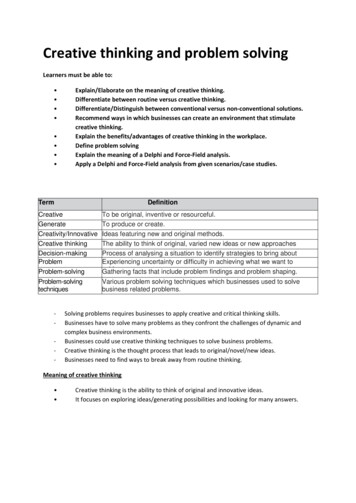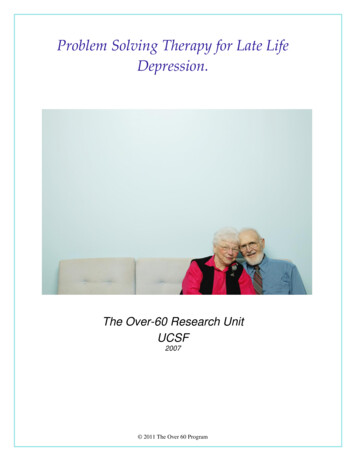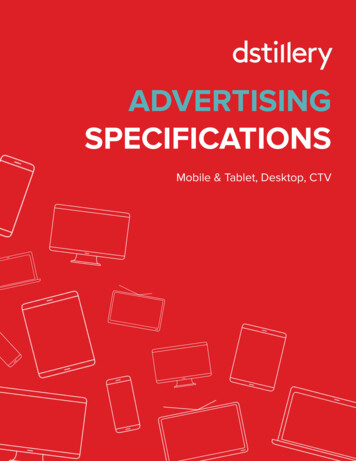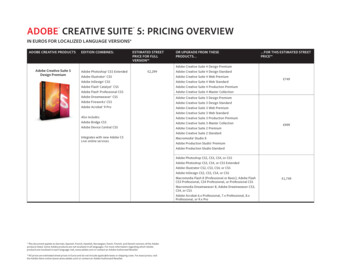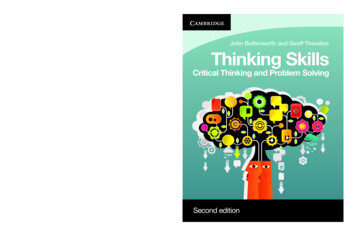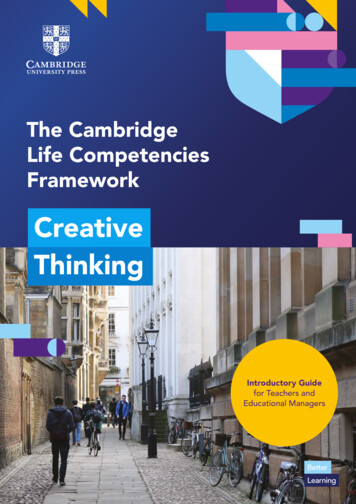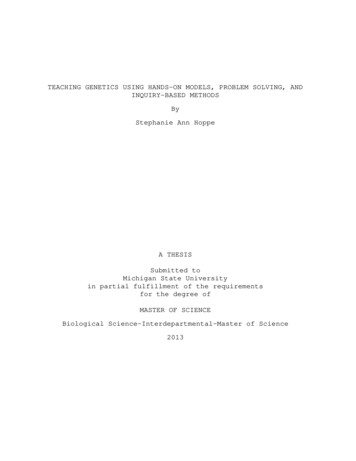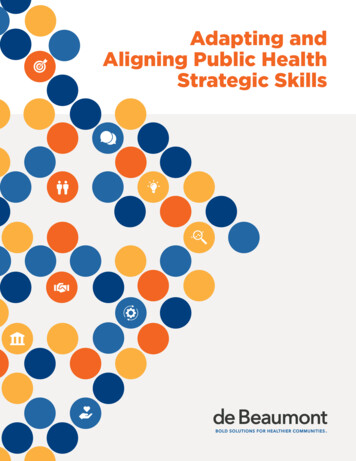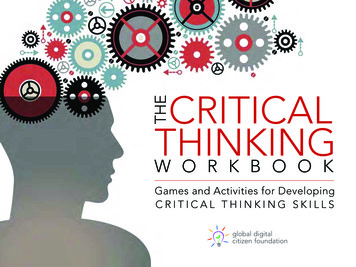
Transcription
CREATIVE THINKING AND PROBLEM SOLVINGDESCRIPTION:Problem solving has traditionally focused on constraining human behaviors tooptimize system performance, but inhibiting behavior has the unwanted sideeffect of inhibiting creativity and innovation as well. In today’s complex andever-changing environment, stifling creativity and innovation are dangerousstrategies. Creative Problem Solving will explore methods for solving problemswith creativity while accounting for human limitations and explore reasons thatinnovation can be challenging. Methods for stimulating new ideas whilemaintaining order and stability in the laboratory setting will bepresented. Cycles of innovation and stabilization, carried forward by inspiredstaff members, will be key to surviving in the current healthcare environment.OBJECTIVES:At the conclusion of this presentation, the participant will: Discuss problem solving skills Describe methods for creative problem solving Apply methods of creative problem solving to the laboratory environment
Creative ThinkingandProblem SolvingMichele FisherMT(ASCP)ASQ Certified Six Sigma Green BeltImprovement Specialist IIIIMSS October 2021
Apple Computer, Inc.The ones who are crazy enough to think that they can changethe world, are the ones who do-Steve Jobs
A problem ofquality suppression ofcreativity &innovation
I am a surgeon who studies creativity, and I have never had a patient tellme that "I really want you to be creative during surgery“ -Charles Limb
quality assurancestabilizingprocess improvementdisruptive
Analytical thinking
Analyze theProblem3easysteps!Identify the problemClarify itFind the cause
Identify the problem and goal1
FromdiscontentTodesirepossibilitiesoptionswhat arewelookingat?choosewhat riskis there?resourcesWhat riskin NOTdoing?support
Goals
Clarify the problem2
UNDERSTAND WHAT ACTUALLY IS never accept that the currentreality is the only realityunderstand the magnitude of the problemdon’t assume that what you are told about the problemis truerecognize that thingschange with timeclearly understand what is known and what is not known;eliminate ambiguityact on what actuallyis, rather than on what you believe istruepay attention to things that “don’t matter”Shigeo Shingo
Problem statementEmployees are expected to process between 10and 15 samples per hour. During the period inwhich increased errors occurred, the averagenumber a samples processed for all employees onthe shift was 7.5 samples per hour.The employees on this shift are idle.
Problem statementKit inventory is 0% accurate electronically, occupies2 rolling shelves of space, and takes over 4 minutesto retrieve supplies causing supply ordering errorsand delays in testing.Kit inventory is problematic.
3Find the cause
Question everything
The Five “Why?”s
Warning!
Established onomicsCulturalRegulatoryWere pressures in the market or new regulatoryrequirements a factor?Are there other external influences?Organizational SeniorManagementOrganizational structurePolicy standards, communicationSafety & risk culture/prioritiesFinancesIs there a culture that increases nonstandardization, poor work or safety habits?Is executive/manager support sufficient?WorkEnvironmentStaffing, skills mixWorkload, shift patternsEquipmentAdministrative/manager supportDoes workload correlate with adequate staffing?Was design or adequacy of the environment oroperation of equipment a factor?Team/UnitCommunication written & verbalTeam leadershipTeam structure/dynamicsWas communication or lack of information involved(i.e. unclear, too late)?Did interactions influence performance?Is decision support available?IndividualKnowledge, skills, competenceDecision makingPhysical, mental health conditionWere issues of staff training/competency a factor?Is situational awareness a needed skill?Is fatigue or workload a factor?TaskDesign and clarityProtocol accessibilityTest result accuracy/accessibilityWere appropriate rules/procedures – or the lackthereof a factor?Are instructions clear?Customer/PatientComplexity, seriousness ofconditionCommunication barriersPersonality and social issuesWas there a lack of understanding with therecipient?Were unclear expectations a factor?Adapted from World Health Organization (WHO), 200922
Degree of changeEstablished PathCreative Path
Creativity Identify Solutions of ValueInnovation Putting those ideas into practice
Laughterhttps://youtu.be/bFEvm336Znc
Missing the meaningful
Enabling creative thinking Global Brain Connectivity Visualization Training Brain Plasticity
Suspending judgment“Are we in the right”“Are we being effective”
Creative Thinking generate totally new ideas(lateral/linear techniques) synthesize from pastexperiences(intuitive techniques)
“Give me numbers”“Riddikulus ““Maybe, maybe not ”De Bonos Thinking Hats“Elementary,my dear Watson”“Attennnntion!”“I am delighted withthat”
Creative Thinking Methods(lateral/linear techniques) AlternativesChange FocusRandom EntryReversingProvocationBrainswarming
Generating Alternatives
Changing Focus
Automated SpecimenTray Tower keep bench top clear move trays from processingto check-in utilize vertical space37
Connect With Random EntryProblem: How can I motivate my team?Bird BinocularsRobinChatterSoundsBinoculars How can I motivate my team?Binoculars Eyes Glasses Reimbursement for GlassesBinoculars Sight Google glasses Relaxation roomsBinoculars Telescope Observatory nearby Local field trips
Reversing/Provocation
Brainstorming Brainswarming DominanceSkepticsIdea conformityCapturing ideasTime consuming Silence Independent work Hitchhiking/newconnections Top-down/bottom-upthinkers
BrainswarmingEncouraging use of PPEGOALSSetting ExpectationsLocate PPE togetherRewards SPPE cBoxesMasksMonthly partygifts for topBoard displayingcomplierscompliance #sHangersClosureVarioussizesfabricLab coats
Creative Thinking Methodsintuitive hunking
Incubation
Abstraction
Test Packet Review (TPR)
TPR Solution 1Bookmarksguidereviewersthrough .pdf(SOP - Charts Test Directory)Coversheetstandardizescomponents
TPR Solution 2Goal to Simplify 25%Goal 80% Compliance66% reductionAvg 6 months 88%47
ObservationTo steal ideas from oneperson is plagiarism.To steal from many isresearch.Wilson Mizner
49
Analogy
Chunking1) Look at these letters for 10 seconds and try to memorize as many of them as possible:2) Now do the same thing with these letters:
Chunking
Creative Solutions to Innovation!
Innovation Blockers
Fear of Failure“What’s the worst that could happen?”
Clinging to Order“The values that people cling to moststubbornly under inappropriateconditions are those that werepreviously the source of their greatesttriumphs.”Jared Diamond, Collapse: How Societies Choose to Fail or Succeed
Cultural Blocks
Environmental Blocks
Intellectual Blocks
Holding Your Gains
SummaryFirst Step Know what you know; know what you don’t knowSecond Step Leave the gate openThird Step Let’s roll!
ResourcesAdams, James L. Conceptual Blockbusting: A Guide to Better Ideas. Cambridge: Basic Books,2001.deBono, Edward. Lateral Thinking: Creativity Step by Step. New York: Harper Perennial, 1990.Limb, Charles. Your Brain on Improve.http://www.ted.com/talks/charles limb your brain on improv.html (accessed August2021).Markman, Art. The Abstraction Method of Problem Solving - Adobe 99U.https://99u.adobe.com/author/art-markman (accessed August 2021).Merrill, Peter. Innovation Generation: Creating an Innovation Process and an Innovative Culture.Milwaukee, WI: ASQ Quality, 2008.Thorpe, Scott. How to Think Like Einstein. Naperville: Sourcebooks, Inc, 2000. e-Book.Young, Scott H. Working Memory: A Complete Guide to How Your Brain Processes Information,Thinks and Learns. g-memory/(accessed August 2021).World Health Organization (WHO). Human Factors in Patient Safety Review of Topics and ethods measures/human factors/human factors review.pdf (accessed August 2021).
2014 ARUP Laboratories
CREATIVE THINKING AND PROBLEM SOLVING DESCRIPTION: Problem solving has traditionally focused on constraining human behaviors to optimize system performance, but inhibiting behavior has the unwanted side effect of inhibiting creativity and innovation as well. In today's complex and
